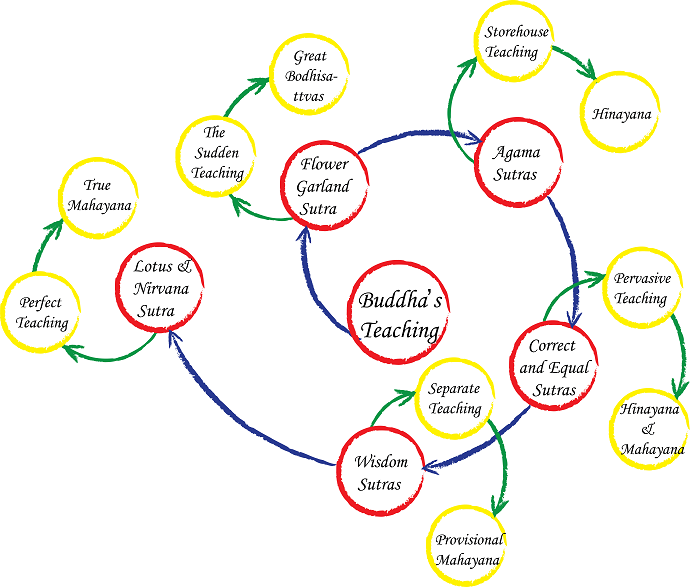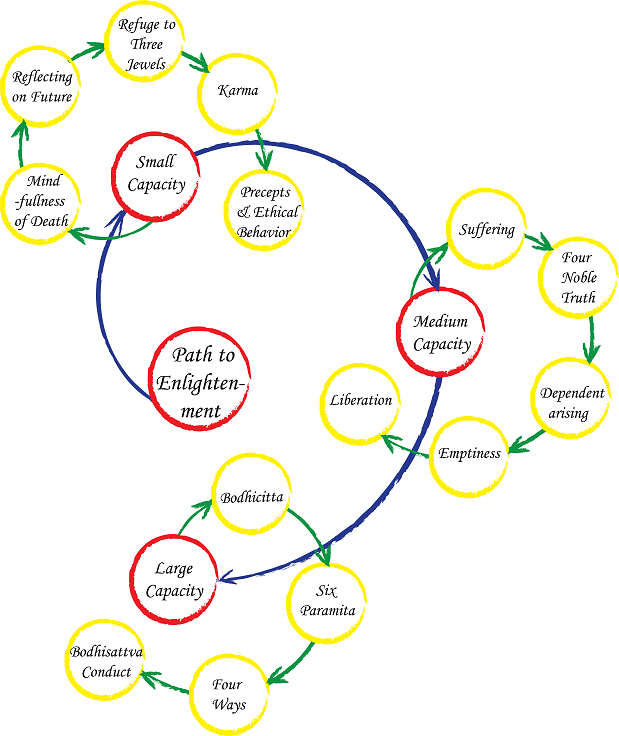Mission of AZC includes six parts: method, cloud thinking technique, volunteer training, practice, study, and cloud community.
Method
The main practice methods AZC follows is the six-step method, which comprises of (1) being Vegetarian, (2) chanting the Sutra of the Past Vows of the Earth Store Bodhisattva, (3) prostrating in accordance with the "Eighty-Eight Buddha Repentance Ceremony", (4) liberating and feeding animals, (5) conducting at least one good deed a day, (6) reciting the name of the Amitabha Buddha. The six-step method is established following the tradition of Pure Land Buddhism, which is a broad branch of Mahāyāna Buddhism and one of the most widely practiced traditions of Buddhism in East Asia. According to the Sutras, Pure Land teaching effectively suits today's times and the Buddhas' intentions. We also practice meditation in various other forms, including mindful prostration, Pureland meditation, Kshitigarbha sitting meditation, Light and sound meditation, etc.
Cloud Thinking Techniques
To practice Buddhism is not just to sit, meditate and get relaxed. The Buddha’s teaching started by observing, identifying, explaining, and resolving our real daily-life problems, such as the pains of birth, oldness, illness, and death. As everybody is facing different problems, the Buddha introduced many ways towards resolutions and awakening. As we practice along the way, we should gradually build up the ability to become more mindful in our daily life, and to resolve our problems as well as to achieve ultimate happiness of liberation. Cloud thinking is a systematic and holistic approach to analyze real-life problems by treating all related elements equally, thinking globally, organizing elements more efficiently, eliminating the boundaries in your thoughts, and identifying the best solutions as well as alternatives. If meditation practice prepares one for emptiness, Cloud Thinking helps one to gain wisdom.
Volunteer Training
Bodhicitta has a central role in Mahāyāna Buddhism. It is a spirit of enlightenment, a spirit that strives toward awakening, empathy and compassion for the benefit of infinite sentient beings. This type of spirit is not only recognized in Buddhism, but in all other religious traditions and among those of no formal religious tradition. It is a fundamental part of the human experience. To volunteer, offering one’s heart and life, giving one’s time and energy, is one of the best way to practice Bodhicitta. In order to set an example, the Buddha himself volunteered to teach the Dharma of liberation and spiritual enhancement for fifty years after he became enlightened. AZC encourages and motivates people to volunteer and has designed systematic training for volunteers so that they can serve others with wisdom and compassion, truly out of free will, kindness, humanity, and charity.
Practice
Diligent practice is a key to success along the way of enlightenment. Only with diligent practice, one can make progress without being obscured. In fact, perseverance is one of the six perfections of the Mahāyāna Buddhism. Samantabhadra Bodhisattva reminds us, ‘As this day has passed, our lives also come to an end. Like fish bereft of water: such is our joy. Dilegently we must strvie, to save ourselves as we would were our hair aflame. Be mindful of impermanence! Beware of complacency!’ AZC places great emphasis on solid practice. In order to help people practice, we hold morning and evening meditation sessions, as well as 2-day and 7-day retreats with intensive practice.
Study
Perhaps all Buddhism traditions agree that the Buddha’s realization is beyond words and books. Indeed, Buddhism is known as a religion that places great value on meditative experience. However, more and more western practitioners have recognized that enlightenment does not come merely at the drop of a flower, and that sitting by itself does not lead to direct realization for most people. If one doesn’t have any knowledge of Dharma, one could even get completely bewildered, confused and come out with wrong views and wrong understanding. Practice needs to be balanced by a good amount of knowledge of Buddha’s teaching. As a matter of fact, even though Zen is said to be based on a "special transmission outside scriptures" which "did not stand upon words", the Zen-tradition has a rich doctrinal and textual background. It has been influenced by Sutras such as the Lankavatara Sutra, the Vimalakirti Sutra, the Avatamsaka Sutra, and the Lotus Sutra. AZC encourages practitioners to study Buddhism scriptures and literature in a systematic and comprehensive manner, in order to deepen the understanding of the principles of Buddhism and the processes of inner transformation, and to support our own Buddhist practice. From Theravada Buddhism to various lineages of Mahayana Buddhism, Buddha's teaching is very comprehensive and covers every aspect, while individuals usually find it difficult to establish a whole picture. According to one of the great Teachings School of Chinese Buddhism, Tiantai School, the Buddha’s teaching is divided into five periods, like the path that the sun travels from when it rises in the early morning until it reaches its full glory at midday.


A big vision of AZC is to integrate Buddhist principles and practice into everyday life, to bring Buddha’s teaching from theoretical to the applied level, and to utilize it to establish better communities, communities that are in peace and harmony. This vision will not be realized without the previous five elements as a solid foundation. AZC seeks the opportunities to purify human hearts and minds through Buddhist practice, to propagate Buddhist teachings through cultural activities, to recognize, analyze and resolve real-life problems, and to foster ultimate self growth through education.